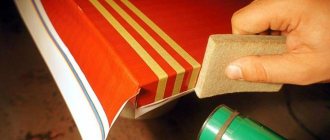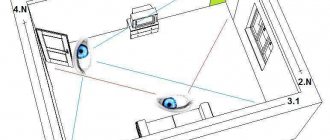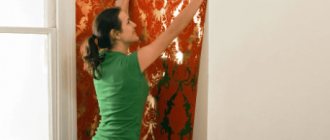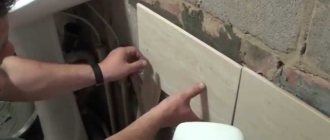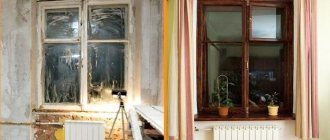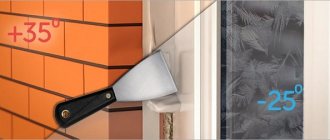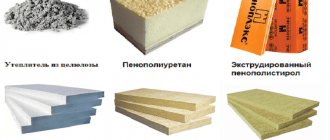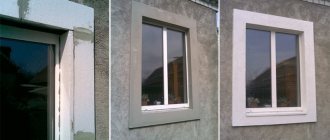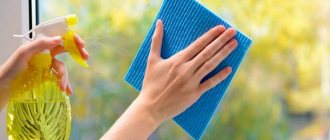Sun protection film - what is it?
This sun protection material is a window tint that consists of the following layers:
- base – dense and polymer film of varying degrees of rigidity;
- infrared-filtering spraying - a very thin continuous and dense layer of metal oxide applied to the base on one side;
- an adhesive layer designed for reliable fixation of the material on the surface of the glass unit. An adhesive layer is applied to the spray;
- protective film located above the adhesive layer.
On a note ! In order to determine which side the protective film of the adhesive layer is on, you need to stick a piece of tape on both sides of the film sheet, in its corner, and pull them in different directions without sudden movements. With this manipulation, a thin protective film is separated from a denser base.
Advantages and disadvantages of solar control film
The main advantages of this material are:
- Preventing indoor air from heating up . Thanks to the metal oxide layer, ultraviolet rays are reflected from the window, so even in hot weather the room temperature will be comfortable.
- Protecting furniture from fading . Sunlight softened by window tinting does not lead to fading of furniture, carpets, wallpaper, and floor coverings.
Soft sunlight prevents fading of furniture and floors Source vitebsk.biz
- Reducing heat loss in winter . In the cold season, window tinting prevents heat loss from the room through a fairly large glass unit.
- Strengthening the glass unit . When gluing window glass with a film (simple athermal or anti-vandal), its strength increases by at least 20-30%.
- Protection against electromagnetic radiation. An oxide layer on the surface of the material prevents the passage of electromagnetic waves through the glass unit, which have a negative effect on the human body.
- Availability and wide variety of different types . In the modern market, this type of material is produced by both well-known world brands and small companies. Thanks to this diversity, the range of sun protection films is represented by products of varying price and quality, accessible to all segments of the population.
The disadvantages of this material are the following features:
- Possible defects due to poor quality installation . The result of such errors can be clearly visible areas with unremoved air bubbles, large particles of debris, material lagging from the surface of the glass unit, large gaps between the sheet fixed on the glass and the side strips.
- Low light levels on cloudy days and bad weather.
If it is cloudy outside, window tinting significantly worsens the illumination in the room. Source mirtonirovki21.ru
The cost of installing the film by specialists is quite high, considering the cost of covering several windows.
Therefore, many recommend purchasing ready-made double-glazed windows with climatic coating right away.
What are the types of protective films for windows?
Basically, two types of films are produced for domestic purposes: for indoor and outdoor use. The first option is most often used. In the assortment of companies supplying these products you can find films:
- decorative - allowing you to change the color of the glass. In particular, they are used to create pseudo-stained glass windows;
- mirrored, can also be used for decorative purposes - for example, finishing glass facades of furniture, partitions, windows and balconies;
- tinting and mirror with protective properties.
If the purpose of tinting a balcony or windows is to reduce illumination and energy loss, it is better to choose a combined model. At the same time, the presence of resistance to impacts and scratches (increased thickness of the film and its special characteristics) will be a bonus even for an ordinary apartment.
Types of solar control film and manufacturers
Before you stick reflective film on the window, you need to choose a high-quality film. To do this, you need to figure out what types of films are right for you, and which brands are most famous.
Types of films
Depending on the design features and additional functions of the material, reflective film comes in the following types:
- athermal;
- mirror;
- anti-vandal;
- decorative
Athermal
This material is a thin and durable film sheet on which a very thin layer of tungsten oxide is applied.
Double-glazed window with applied athermal film Source tonirovka-okna.ru
See also: Catalog of companies that specialize in the manufacture and installation of doors and windows.
- Thanks to the use of nanotechnology and modern high-precision equipment in the manufacturing process, this film, compared to analogues of other types, has the following features:
- invisibility - due to its small thickness it is practically invisible on the surface of the glass unit;
- high light transmittance - up to 70% of sunlight passes through the oxide coating;
- reliable protection from ultraviolet rays - the material blocks up to 99% of ultraviolet radiation;
- lack of tinting effect and mirror surface;
- a wide variety of colors - from colorless to light blue.
The main disadvantage of this material is its rather high price - from 1200 to 2500 rubles/sq.m.
Mirror
This type of solar control material for windows is the most common and in demand on the market. It is a dense film, one of the surfaces of which is opaque with a mirror finish (glossy or matte).
Balcony windows with mirror tinting Source yandex.net
This material is used not only to shade rooms and prevent the air in them from heating up in extreme heat, but also to protect the privacy of apartment residents from prying eyes from the street. The latter function of this material is especially relevant in apartments with windows on the ground floor next to busy streets, roads, sidewalks, pedestrian and bicycle paths.
Important ! Before you stick the mirror film on the window, it is worth remembering that it has the effect of one-way visibility only during daylight hours when the indoor lighting is turned off. In the evening, at night or in the pre-dawn twilight, with the interior lighting turned on, everything that happens inside the room is quite clearly visible. In such cases, experts advise using mirror tinting along with light, adjustable blinds.
Anti-vandal
Anti-vandal film is a material that not only reduces the level of ultraviolet radiation from sunlight penetrating indoors, but also, having high strength, prevents various mechanical impacts (impacts from heavy objects, blast waves, etc.)
Anti-vandal film coating allows you to increase the strength of a double-glazed window several times Source www.apteekkari.fi
Kinds
All types reflect the sun's rays, but there are features of the sun protection film for its intended purpose, which should be taken into account when choosing.
Toning
Tinted or reflective is used to darken the room. Absorbs most of ultraviolet radiation. Does not reduce the optical properties of the window. Protects the interior from exposure to direct sunlight.
Mirror
It will perfectly hide your life from prying eyes. It has one-way visibility, i.e. from the outside it works like a mirror. The glass does not heat up, scorching rays do not pass through, you can safely leave flowers on the windowsill in the heat without fear that they will burn.
Protective
It is called differently - anti-vandal, armored, protective. The special feature is to protect the window from blows and protect it from flying fragments. Often used in banks, offices, country houses. Select by protection class. It depends on the thickness of the film.
Energy saving
Does not allow sunlight to pass through in summer, and retains heat in the room in winter. But it does not accumulate heat in the off-season.
The only one of the reflectors does not have an adhesive base. Fix with a hairdryer.
Metallized
Made from transparent material - polyester. A metal layer of aluminum, bronze, silver, and gold is sprayed on top. Therefore, the metallic look comes in a variety of shades. Has one-way visibility, with varying degrees of transparency.
Apply to any glass surface. Often used for exterior decoration of cafes, offices, and homes.
For decorative purposes, interior items and interior partitions are also used indoors to create a mirror effect.
Looks stylish on both sides of the glass. Gives the interior a pleasant darkness.
Fix at temperatures from +10 °C to +40 °C. At temperatures lower or higher there may be problems with adhesion.
Decorative
Its properties are similar to metallized ones, but they are used only for interiors. They are produced with drawings, matte. The top is covered with a protective layer against damage. The service life is limited by the life of the surface on which it was glued. Suitable for any waterproof materials. They decorate windows, mirrors, interior and office partitions.
Athermal
Athermal (heat-protective). Made from modern polymers, they are more effective in reflecting infrared (heat) rays than reflective or mirror ones.
When using this type, interior items and furniture do not lose color longer, the room heats up less, the transparency of the glass does not change, and therefore energy is saved.
In terms of technical characteristics, athermal ones, due to the physical properties of the material, are ahead of reflective ones. This type reflects precisely the heat from the sun's rays.
It is also superior in transparency to the above-mentioned types. It is almost invisible on the window, but creates a pleasant shadow shade inside the room.
Like other films, it absorbs UV and IR radiation in the summer, but retains heat in the winter.
The top is treated with a protective layer from external damage. Over time, it does not lose its heat-protective properties.
Technology of covering windows with solar control film
Before gluing self-adhesive film to glass, you need to prepare the necessary materials and tools and understand the technology of work. Let's take a closer look.
Materials and tools
To cover windows with sun protection, you need to prepare:
- sun protection film;
- soap solution.
The following tools are used for work:
- a sharp utility knife or surgical scalpel;
- plastic spatula;
- special spatula for washing windows (rubber water squeegee).
Rubber squeegee for washing window glass Source shikblesk.com
- manual sprayer (small sprayer with a tank and pumping);
- clean cotton soft cloth.
how to properly glue film to a window
do-it-yourself installation of sun protection, tinting and decorative films
technology for installing film on windows
The technician will paste the film on the window in 3-5 minutes. It may take you a little longer.
- Wash the window;
- Wet the glass;
- Attach the film;
- Remove water and air from under the film.
- Trim excess film around the edge of the glass
1. First you need to clean the glass with window cleaner.
If you don't have it on hand, you can dilute dishwashing detergent in water.
Apply the solution to the glass and wipe with a clean cloth or remove the water with water distiller.
If any dirt remains, repeat the procedure.
2. Moisten the glass with a spray bottle containing the installation solution: 1 cap of baby shampoo per 1.5 liters of water (for example, Johnson & Johnson, or you can use Fairy).
3. Remove the transparent protective layer from the prepared piece of film, to do this, glue the tape on both sides and sharply pull in different directions, a dark sticky film will remain on one tape, and a transparent film on the other.
Wet the film. The film must be completely wetted. Water (installation solution) temporarily neutralizes the adhesive, allowing the film to move across the glass surface.
Place the upper corners of the film on the glass and fix (smooth) them.
Distribute the film over the surface of the glass, avoiding the formation of folds and creases.
4. Re-wet the surface of the installed film. Water will ensure easy sliding of the water scraper (scraper or rubber spatula) and will not allow scratches to form if hard debris gets caught under the removal.
Proceed to smooth the film and expel (squeeze) the installation solution from underneath it.
Start work from the central upper part of the canvas. Move the forcing (scraper or rubber spatula) from the center to the edges, from top to bottom.
First with light movements, then gradually increasing the pressure. There should be no air bubbles or water “lenses” remaining under the surface of the installed film.
5. Trim the excess film extending beyond the edge of the glass with a stationery knife, forming a gap of 1-2mm (optional). This gap is necessary for the installation solution to escape.
Squeeze out the water using short forcing movements directed perpendicular to the edge of the film.
Tip: to more effectively remove water protruding from under the edge of the film, wrap the forcing with a paper napkin - the escaping water will be absorbed into it.
Do not wash the film for 5 days after installing it to prevent moisture from getting under the film and causing watery lenses.
It's better to see it once
Watch the video: how to install film on windows with your own hands without bubbles and wrinkles in three minutes
Many people are looking for this article for the following queries: covering windows with film, how to glue solar control film on a window, installing solar control film on windows, how to stick sun control film on a window video, how to stick tinting film on a window, how to glue solar control film on a window, film sticker on windows, cover a window with film, how to glue film on a window from the inside,
how to glue film on the windows of a house, paste film over windows, how to properly stick film on window glass, technology for gluing decorative film on windows, how to glue solar reflective film on windows, how to glue sun-protective film, self-adhesive film on windows, how to glue and dozens of similar variations with similar meanings but different in spelling.
Briefly about the main thing
Before gluing a solar control film to a window, you need to choose the right manufacturer, determine the necessary parameters for protection against UV radiation and the type of film.
The most popular brands: SunProtect, Velx eurowin, Armolan.
Types of film for pasting:
- Athermal;
- Mirror;
- Anti-vandal and decorative.
After the right choice has been made, they begin pasting. To do this, prepare the glass surface by cleaning it from dust and moisture. Next, gradually freeing it from the adhesive layer, stick it to the surface using a soap solution and a spatula.
Ratings 0
Types of sun protection coatings
In the retail chain, solar control film for windows is presented in the following types:
- metallized (mirror);
- non-ferrous metallized;
- energy saving;
- decorative
The simplest is a metallized film that tends to repel sunlight. It is glued both outside and inside. Adding any pigment allows you to change its color, which does not affect its reflective properties.
To protect glass from heat loss, an energy-saving type is used, which contains a special layer that does not release infrared rays from heat sources to the outside. Decorative films not only protect the window, but also decorate it.
The film is glued to windows not only as a means of protection from the penetration of direct rays of the sun, but also to keep the room cool.
